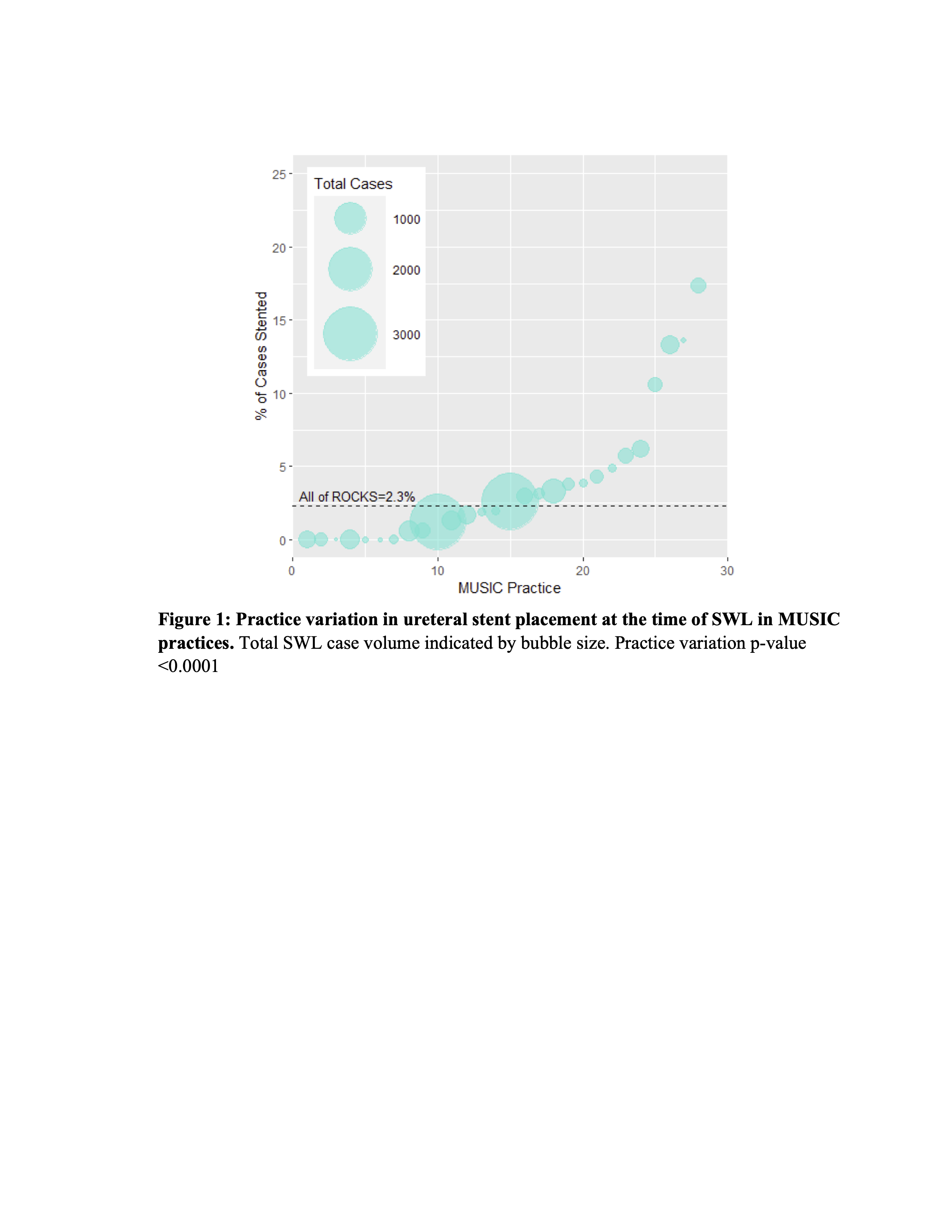Back
Introduction: Shockwave lithotripsy (SWL) is a commonly performed stone procedure in the US. AUA guidelines do not recommend routine stent placement for SWL patients. We evaluated statewide practice patterns and predictors for stent placement at the time of SWL and whether stent placement affected stone free rates (SFR) and 30-day complication rates.
Methods: Adult patients undergoing SWL between 2016-2022 were identified using the MUSIC Reducing Operative Complications from Kidney Stones prospectively collected registry. We determined stent usage prior and during SWL across practices and collected demographic, clinical, stone and procedural factors. Outcomes included peri-operative management, complications and SFR. Multivariable logistic regression was used to identify predictors of stent placement at time of SWL.
Results: Among 13,063 cases identified from 35 practices (222 urologists), wide practice variation in stent placement patterns were noted ranging from 0-17% (Figure 1). Overall, 2.3% cases were stented at the time of SWL and 15.5% had a prior stent. Stent on a string was performed in 26 cases (9%) by 11 urologists (54% by 1 provider). Stented SWL patients (prior/time of SWL) were more likely to be older, have a higher Charlson comorbidity index, solitary kidney, 1st upper tract stone, ureteral stone, larger stone, hydronephrosis and positive urinalysis/urine culture (all p<0.01). Stented patients were more likely to have peri-op and post-op antibiotics and anticholinergics (p < 0.001). Predictors of stent placement at time of SWL included ureteral stones (OR1.6, 95%CI 1.1-2.3, p=0.01), larger stones (OR1.2, 95%CI 1.216-1.23, p<0.001), African-American race (OR1.8, 95%CI 1.03-3.0, p=0.039) and hydronephrosis (OR1.8, 95%CI 1.3-2.6, p<0.001). There were no differences in emergency department (ED) visits between stented and unstented patients (5.3% vs 3.9%, p= 0.21) or 60-day SFR (34% vs 40%, p=0.10). Stented patients had significantly higher infectious complications (3% vs 0.6%, p<0.001).
Conclusions: Variation exists amongst urologists regarding stent usage with SWL, influenced by specific patient and stone factors as well as provider preference. Although ED visits and SFR did not differ, stented patients had a significantly increased post operative infection rate. SOURCE OF
Funding: Blue Cross Blue Shield of Michigan

Moderated Poster Session
Session: MP54: Health Services Research: Practice Patterns, Quality of Life and Shared Decision Making III
MP54-07: Stents and Shockwave Lithotripsy - the Who and the Why: Results from a Statewide Collaborative
Sunday, April 30, 2023
9:30 AM – 11:30 AM CST
Location: S401A
- SM
Sami Majdalany, MD
Research Fellow
Vattikuti Urology Institute, Henry Ford Health
Poster Presenter(s)
Introduction: Shockwave lithotripsy (SWL) is a commonly performed stone procedure in the US. AUA guidelines do not recommend routine stent placement for SWL patients. We evaluated statewide practice patterns and predictors for stent placement at the time of SWL and whether stent placement affected stone free rates (SFR) and 30-day complication rates.
Methods: Adult patients undergoing SWL between 2016-2022 were identified using the MUSIC Reducing Operative Complications from Kidney Stones prospectively collected registry. We determined stent usage prior and during SWL across practices and collected demographic, clinical, stone and procedural factors. Outcomes included peri-operative management, complications and SFR. Multivariable logistic regression was used to identify predictors of stent placement at time of SWL.
Results: Among 13,063 cases identified from 35 practices (222 urologists), wide practice variation in stent placement patterns were noted ranging from 0-17% (Figure 1). Overall, 2.3% cases were stented at the time of SWL and 15.5% had a prior stent. Stent on a string was performed in 26 cases (9%) by 11 urologists (54% by 1 provider). Stented SWL patients (prior/time of SWL) were more likely to be older, have a higher Charlson comorbidity index, solitary kidney, 1st upper tract stone, ureteral stone, larger stone, hydronephrosis and positive urinalysis/urine culture (all p<0.01). Stented patients were more likely to have peri-op and post-op antibiotics and anticholinergics (p < 0.001). Predictors of stent placement at time of SWL included ureteral stones (OR1.6, 95%CI 1.1-2.3, p=0.01), larger stones (OR1.2, 95%CI 1.216-1.23, p<0.001), African-American race (OR1.8, 95%CI 1.03-3.0, p=0.039) and hydronephrosis (OR1.8, 95%CI 1.3-2.6, p<0.001). There were no differences in emergency department (ED) visits between stented and unstented patients (5.3% vs 3.9%, p= 0.21) or 60-day SFR (34% vs 40%, p=0.10). Stented patients had significantly higher infectious complications (3% vs 0.6%, p<0.001).
Conclusions: Variation exists amongst urologists regarding stent usage with SWL, influenced by specific patient and stone factors as well as provider preference. Although ED visits and SFR did not differ, stented patients had a significantly increased post operative infection rate. SOURCE OF
Funding: Blue Cross Blue Shield of Michigan

